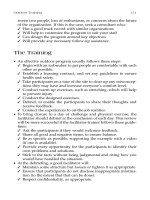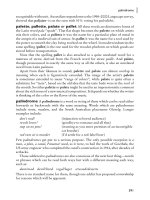the nordstrom way to Customer Service Excellence phần 8 pdf
Bạn đang xem bản rút gọn của tài liệu. Xem và tải ngay bản đầy đủ của tài liệu tại đây (163.09 KB, 28 trang )
Recognition, Competition, and Praise
179
f loor or across the country. Each salesperson’s semimonthly sales-
per-hour figures are posted clearly for all employees to see.
The Harvard Business Review detailed one spirited 1979
sales-goal meeting, where the regional manager had asked every
department manager and buyer to write down their sales targets
for the following year:
As the figures were called out, the regional manager wrote
the amounts against the individual’s name on a large chart.
Next to the figure in turn was a space on which the regional
manager had written his target for each manager. That tar-
get figure was kept covered during the initial part of the
meeting in which the managers gave their target figures for
the year.
Then, amidst great excitement and suspense, the regional
manager tore off the slip of paper, which covered his target
for each individual manager. If the sales target of the manager
was under that of the regional manager, the assembly would
boo the unfortunate manager. However, if the manager’s tar-
get was above that of the regional manager, then the group of
persons would break out into cheers.
One manager described the scene as being similar to a
classroom during an exam, with all the store managers and
buyers doing feverish calculations as they heard what their
peers were setting as targets and were tempted to revise their
own targets.
That scenario is not unusual; in fact, it’s the norm. Every top
Nordstrom salesperson is goal-oriented. Literally all of these stel-
lar performers feed off of the recognition they receive from their
customers and from Nordstrom, and they are motivated by reach-
ing their goals. The best of the best set ambitious goals for them-
selves and when they meet those goals, they continue to set the
WHAT SUPERVISORS CAN DO
180
bar higher and higher—and work harder and harder to sell more
and more year after year.
At Nordstrom, the best salespeople achieve the status of Pace-
setter. Pacesetters, who typify the entrepreneurial Nordstrom
sales culture, meet or surpass the sales volume goal for their spe-
cific department for the one-year period from December 16
through December 15 of the following year. To maintain Pace-
setter status, each year Nordstrom raises the target goal figures,
depending on how many people achieved Pacesetter the year be-
fore. Generally, 8 to 12 percent of the salespeople in each divi-
sion make Pacesetter.
Kazumi Ohara, who manages the Chanel handbags depart-
ment in the downtown Seattle store, has been a Pacesetter for
many years. To track her goal of reaching the Pacesetter target,
Ohara divides the pay year by quarters, subdivides the quarters
by six two-week pay periods, and then records her earnings for
each pay period. She boosts her target level every year.
Pacesetters are given a personalized certificate of merit, busi-
ness cards and note cards emblazoned with the Pacesetter desig-
nation, and a 33 percent store discount credit card (13 percent
more than the regular employee discount) for one year, and cash,
which varies, depending upon how many years the individual
achieved Pacesetter status. After 10 years with the company, Pace-
setters receive a Nordstrom stock award, which varies depending
upon how many years they have achieved Pacesetter status.
Stephenie Melton, who sells women’s apparel at the Fashion
Valley store in San Diego, became a Pacesetter in her first year at
the company in 1984. That year, she attended her first Nordstrom
annual dinner honoring all Pacesetters. That night, “Somebody
was being rewarded as a 20-year Pacesetter. Becoming a 20-year
Pacesetter became my goal.” Melton achieved that goal in 2004.
Recognition, Competition, and Praise
181
The company rewards other top performers with incentives
such as cash and gifts. Every month, each store manager selects
Customer Service All-Stars based on outstanding, consistent cus-
tomer service, individuals’ sales volumes and the level of support
they give their coworkers. All-Stars are given a 33 percent store
discount for one year. Based on three criteria—sales volume, cus-
tomer service, and teamwork—Nordstrom rewards people with
the best work shift schedule. The definition of the “best” shift
depends on the individual. Some prefer the busiest times; others
opt for shifts that best fit into their personal lives.
To qualify for the added recognition of being named a Pace-
setter All-Star, individuals must be the top salesperson in their
goal group, measured on a company-wide basis. In addition, they
must have been in the same goal group for the entire payroll year
to be eligible for this special recognition.
Pacesetters who surpass one million dollars in sales volume
for the Pacesetter year, earn membership in the exclusive Million
Dollar Club. In 2003, 50 employees made the club, up from 32
the year before.
Commission Sales versus Customer Service.
Some might feel that there is a dichotomy between giving spectac-
ular customer service and earning commission sales. It’s true that,
in some cases, salespeople are happy to get the sale and are even
happier to move on to another customer. They don’t see themselves
in a long-term relationship with a customer because they don’t see
themselves in a long-term relationship with their job.
At Nordstrom, top salespeople argue that because their com-
pensation is linked to satisfying the customer, it’s in their best in-
terest to act responsibly. The best Nordstrom salespeople know
WHAT SUPERVISORS CAN DO
182
that if they take care of the customer, the dollars will follow. But
they can’t look at the customers with dollar signs in their eyes.
With Nordstrom’s liberal, virtually unconditional, money-back
return policy, if people aren’t happy with what they’ve purchased,
they are going to bring it right back. That means that everyone’s
time is wasted—the salesperson and the customer. “A happy cus-
tomer will refer me to her friends,” said a retired Nordstrom
salesperson. “She won’t do that for someone she feels doesn’t have
her best interests at heart.”
And as Patrick McCarthy pointed out, “I want to make sure
that the customer leaves with everything he needs. But I don’t
think about the cash register; it’ll always be there.”
The Customers Always Write.
At Recognition Meetings, customers’ letters of appreciation are
read and positive achievements are recognized, while coworkers
stand up and cheer for each other.
For example, here’s one about salesperson Melinda Mason. A
customer wrote:
You should think strongly about promoting this woman. I
am deaf, and I wanted slippers for my mother. I left the old
slippers in my other car. Melinda called my husband for me
( I can’t use the phone), got the size, and talked him into
shopping for dinner for us (no time in my schedule today to
shop) and cooking it!
Nordstrom executives read all the letters that come in from
customers, attach notes for the store managers to review. Kuntz
said that he handwrites 60 notes to salespeople who are
mentioned. “I usually get back letters from those people. One
Recognition, Competition, and Praise
183
salesperson whom I didn’t know wrote back to me and said
herhusbandhadframedthenotefrommeandputitontheirre-
frigerator.”
Letters of complaint about Nordstrom’s customer service are
also read over the store intercom (omitting the names of the of-
fending salespeople). “That’s how we learn that the customer is
our boss,” said Patrick McCarthy. “Nordstrom’s name is on my
paycheck, but I’m paid by the customer.”
Today, the signature on employees’ paychecks reads: “Blake
Nordstrom on behalf of the customer.”
Implementation Lessons from Other Companies.
At Mike’s Express Carwash, “We constantly remind our people
that the customers make this all possible,” said President Bill
Dahm. “We tell them, ‘We sign your paychecks, but when the
people that you’ve given good service to come back time and
time again, they are making all this possible.’ Repeat business is
what makes this thing work.”
Mike’s constantly reinforces its commitment to customer ser-
vice by reading customer comment cards—both good and bad—
at employee meetings. And Mike’s answers every one of those
customer comment card because part of a company’s commit-
ment to customer service is reinforcing that commitment with
its customers.
A review of the letters that Mike’s receives from customers
shows that the vast majority have to do with small but significant
things: scuffs and dullness on the hood and roof; an emblem miss-
ing from the front grille of a car; dissatisfaction with the way an
employee operated a customer’s stick-shift. Those things may be
small, but when it happens to you, they become significant. In
each one of those instances, Mike’s employees made sure the
WHAT SUPERVISORS CAN DO
184
cus
tomer received satisfaction, and in virtually every instance,
the customer was taken care of without a frontline employee hav-
ing to ask his or her boss for permission because the employees
know they are supported by their management’s 100 percent
commitment to customer service.
Gordon Bethune, retired CEO of Continental Airlines, be-
lieves that part of his job is recognizing great individual perfor-
mances. “Every time a customer writes me and commends an
employee, not only will I write back to the customer, I will
also handwrite a little note to the employee, underline the nice
things that were said, and write thank you. Because we get a lot
of nice letters, I do a lot of that—and it pays off,” he said. If
flight attendants and other employees who have personal con-
tact with customers, receive five such letters, Continental hands
out a special star to be worn on their uniform. “People know
that you are being recognized as someone who gets a lot of
accolades.”
“Recognition and praise are the best motivators I know.
When you recognize and praise your people, they will go out
and do anything for you,” he said. “Every time you talk to me
you’re going to hear me talk about my team and how wonderful
they are, and what they did.”
Keys to Success
Ⅲ Always find an opportunity to praise employees for great
acts of customer service.
Ⅲ Recognize and reward those great acts.
(Continued)
Recognition, Competition, and Praise
185
(Continued)
Ⅲ Use financial rewards to encourage customer service.
Ⅲ Provide your employees with information on how they are
doing—and how the competition is doing.
Ⅲ Sent notes of praise to employees who give great cus-
tomer service.
EXERCISE
Praising Your Employees
Ⅲ Ask each person to think of a fellow employee—a peer or
someone who works for you or with you—who gives great
customer service.
Ⅲ Write a note of recognition and praise for that person.
Ⅲ Send the note to that person.
EXERCISE
Organize Recognition Meetings
Ⅲ Select a committee to create and organize the meetings.
Ⅲ Organize an agenda.
Ⅲ Decide on a purpose and objective for the meeting.
Ⅲ Create awards and other forms of recognition.
Ⅲ Have the meeting.
(
Continued)
WHAT SUPERVISORS CAN DO
186
(Continued)
Ⅲ Videotape the meeting so that the committee can critique it
later.
Ⅲ Distribute feedback forms to those in attendance. Get their
comments on the meeting, and incorporate those suggestions
into the planning for the next meeting.
EXERCISE
Make Your Company Special
Ⅲ Create a contest similar to Nordstrom’s Make Nordstrom
Special, where employees are asked to come up with pro-
motions and suggestions to drive results.
Ⅲ Create a good reward for the winners.
Ⅲ Make this contest a regular part of your culture.
EXERCISE
Goal Setting
Ⅲ Assemble several of your people from all departments of
your company.
Ⅲ Direct those people to brainstorm on company goals, both
individual and collective.
(Continued)
Recognition, Competition, and Praise
187
(Continued)
Ⅲ Compile an official list of those goals and distribute them
to everyone in the organization.
Ⅲ Find ways to reward individuals and departments who
achieve those goals.
EXERCISE
Customer Feedback: Letters
Do you get letters from customers?
Ⅲ Collect those letters—both positive and negative.
Ⅲ Edit them.
Ⅲ Distribute those edited letters to your colleagues.
Ⅲ Act upon the suggestions that customers have made in
those letters.
Ⅲ Use those letters to help create a customer service culture in
your organization.
189
P
ART
III
WHAT EMPLOYEES
CAN DO TO CREATE
NORDSTROM-STYLE
SERVICE
T
his part examines the role of the people on the frontlines
of your organization, and the inf luence they wield in
making your company a customer-service organization.
First of all, frontline people must buy into the culture and
understand their role in maintaining and supporting the culture
through their actions.
Frontline people are generally the ones who come in clos-
est contact with your customers. Therefore, they are crucial to
your organization’s ability to give customer service. They must
be empowered to establish relationships with your customers
and to find ways to take care of your customers in every way
possible. They must be able to listen to the customer, under-
stand the customer’s needs, and follow through with whatever
needs to be done.
Frontline people must have a thorough knowledge of the
products and services your organization offers because it is
THE NORDSTROM WAY
WHAT EMPLOYEES CAN DO
190
through those products and services that relationships are cre-
ated, nurtured, and maintained.
Frontline people must be team players because it is through
teamwork that cultures are formed and sustained.
In this part, we see the value and the importance of the in-
dividual within the organization, and how each person—who
is honest, ethical, hardworking, and empathetic—can help to
create a customer-service culture.
191
Sell the Relationship
How Frontline Salespeople
Create Lifetime Customers
We are each of us angels with only one wing, and we can only fly
by embracing one another.
—Luciano de Crescenzo
10
193
I
n your company do you value relationships? Do you have an
organization that promotes a culture where building and main-
taining relationships with customers are essential elements to your
customer-service philosophy?
Patrick McCarthy is Nordstrom’s all-time top salesperson.
Until he retired in early 2000, after 29 years with the company,
Pat was the quintessential Nordstrom employee. For the last 25
of those years, Pat sold men’s tailored clothing in the downtown
Seattle store, and was Number One in sales throughout the chain
for an astonishing 15 years in a row. An entrepreneurial self-
starter like all top Nordstrom salespeople, McCarthy, who con-
sidered himself “a franchise within a franchise,” was undoubtedly
the best-known salesman in Seattle. Drawing from a personal
client list of 7,000—from recent college graduates to chief ex-
ecutive officers to United States senators—he racked up well over
$1.5 million in sales every year.
Pat tells the story of playing golf one day with a couple of
people who didn’t know who he was. At the first tee, one
stranger who was in his foursome asked the typical question:
“What do you do for a living?”
To which Pat replied: “I sell a relationship.”
The questioner looked at Pat kind of funny, and returned to
the golf game. But at the second hole, he had to ask the question
again: “No, really, what do you do for a living?”
Pat replied: “I sell men’s suits at Nordstrom.”
WHAT EMPLOYEES CAN DO
194
“Oh, so that’s what you do,” said the stranger, fully satis-
fied with the answer.
“No,” Pat replied. “That’s not what I do. What I do is sell
relationships.”
And that’s exactly what most successful businesses and sales-
people do: Sell relationships. It is axiomatic that people like to
do business with people they like. If your product or service is
similar to your competitor’s, and the price for that product or
service is similar to that of your competitor, what will be the
reason why you will get the business and not your competitor?
The answer to that question is the relationship you have with
your customer and the trust you have built up over time. Once
you’ve established and nurtured that relationship, why should
your customer go anywhere else?
McCarthy’s first indication of the value of selling a relation-
ship came when he first joined Nordstrom in 1971 and saw how
Ray Black, then the company’s most successful men’s clothing
salesman, had made a successful living from the relationships he
had developed with his customers. Black taught McCarthy the
value of something as simple as remembering customers’ names.
Black had the ability to recall a customer’s last purchase. He
would make suggestions for purchases and offer choices.
Black was so good that customers would come into the Nord-
strom men’s wear department and ask for him. If he wasn’t
working that day, they would leave and come back on a day when
he was working.
Create Relationships While You’re “Measuring
Both Feet”.
For many years, a Nordstrom executive named Pat Kennedy
oversaw the company’s men’s shoes division, which accounted
Sell the Relationship
195
for about a quarter billion dollars in sales. Year in and year out,
Kennedy’s division had some of the best financial performances
of any other division in the Nordstrom chain.
Someone once asked the since-retired Kennedy what he in-
structed the salespeople in his division to do in order to produce
such results. His answer was a line that he heard often over the
years from one of his mentors, Bruce Nordstrom: “I tell them to
measure both feet.”
Measure both feet? In the literal sense, a knowledgeable shoe
salesperson will measure both feet because she knows that a cus-
tomer’s right foot might be a slightly different size than the left
foot. So, by measuring both feet, she is showing the customer
that she knows what she’s doing.
“People need to understand the dynamics of how you actu-
ally measure a foot,” says Jack Minuk, vice president of women’s
shoes. “How do you put a shoe on a customer that actually fits
the foot? Even though a customer may measure a certain size, in
reality, there is no universal fitting standard in the footwear in-
dustry. With our hands-on training, our people understand the
nature and anatomy of the foot to best fit her feet.”
When a customer has over a size-and-a-half difference be-
tween shoe sizes for her right and left feet, it has been a Nord-
strom policy for many decades to split sizes so that the customer
doesn’t have to buy two full pair of shoes.
Just as important as the actual measurement, is the salesper-
son’s taking the time to talk to the customer and to begin plant-
ing the seeds of a relationship by asking pertinent questions: What
kind of business are you in? Are you on your feet all day? Do
you need dress shoes or more casual shoes? Do you play sports?
Do you need shoes for those activities? Do you have foot prob-
lems? All the while, that salesperson is creating a relationship by
taking note of what the customer is telling her.
WHAT EMPLOYEES CAN DO
196
What do you do in your business to create a relationship?
When it comes to customers, new and old alike, how do you—
metaphorically speaking—measure both feet?
Listen to the Customer.
For successful salespeople like Leslie Umagat, the process of cus-
tomer service “starts by just listening to the customer. Deter-
mine what her needs are and provide solutions through the
resources and merchandise that you have.”
Salespeople who develop an understanding of customer ser-
vice the Nordstrom way have taken the time to grasp the intri-
cacies of the system and to customize it to their own personality
and talents. “The best salespeople in Nordstrom have found,
through trial and error, what they do best,” said David Butler,
a retired shoe salesman who worked in the Tacoma store. “Not
everybody can be a Pacesetter, but everybody has certain
strengths.” Top salespeople believe in making customers your
best friends. Added Butler, “Treat customers like royalty and
let them know that you will take care of them. Customers are
here to spend money, so make them happy.”
At Nordstrom, customer service means treating each customer
as an individual, learning the customer’s likes and dislikes, and
treating her as a whole person. Customer service comes from the
heart. Then individual salespeople add their own personal touch,
creating a situation where the customer feels as if she is working
with a friend, rather than just a salesperson.
The Personal Book.
Personal books have been a part of the arsenal for Nordstrom sales-
people for many years. In the old days, personal books were loose-
leaf notebooks that contained vital information on every customer,
Sell the Relationship
197
including phone numbers, credit card numbers, names of spouse
and children, previous purchases, sizes, vendor preferences, likes
and dislikes, special orders, and any other characteristics, such as
being a difficult fit or preferring to shop during sales events, and
so on. Today, personal books are no longer physical notebooks;
they are all computerized in a customer-service software package.
“The physical personal books were good, but sometimes very
inconsistent. This allows more consistency and, therefore, better
relationships,” said Brian Townsend, store manager of the Tacoma
Mall. “The more information we can remember about our cus-
tomers, the easier it is for them to shop.” By remembering perti-
nent information about their customers salespeople become more
closely connected with those customers.
According to an internal Nordstrom survey, the company’s
million-dollar-sales salespeople said that 68 percent of their busi-
ness comes from personal trade, which makes the personal book
an invaluable tool.
If Stephenie Melton can’t find an item that a customer has
requested, she makes sure she gets back to that customer because
“if you follow through, you will have a customer for life. They
know that you put the time in to find what they were looking
for. Don’t drop the ball. A customer is looking to do business
with someone they can trust.”
Christerlyn Williams is a Nordstrom salesperson in the
Michigan Avenue store in downtown Chicago. One day, a cus-
tomer expressed interest in a leather coat in one of the women’s
wear departments. The customer, a bargain shopper, told Chris-
terlyn, “I love the coat but it’s way too expensive. But if it ever
goes on sale, will you let me know.” Christerlyn said she would
do that and took the customer’s business card.
“I just kept the list and when I would go through my personal
book, I would see her name. I was waiting for that coat to go on
WHAT EMPLOYEES CAN DO
198
sale, and when it did, I called her.” Needless to say, the customer
was happily surprised; overwhelmed. Christerlyn shipped the
coat to her directly.
“That was the beginning of our relationship,” said Christerlyn.
“Christerlyn, to me, is very special,” said the customer. “The
f irst thing I do when I come to her department is ask for her. She
is very willing to do more than I expect and she connects with
me very well.”
As for Christerlyn, whenever the customer tells her that she’s
coming into the store, “I can’t just stay in my own department.
I have to move around and go from department to department
because I know she needs panty hose, she needs a scarf, she needs
something. And I’m going to be the one to sell it to her because
she’s my customer.”
Nordstrom salespeople like Christerlyn and Stephenie and the
others featured in this book take ownership of the customer. But
what’s even more remarkable about the Nordstrom culture is
how customers feel about Nordstrom salespeople. When Robert
Spector speaks to business groups, invariably someone in the au-
dience will come up after his presentation and start the conver-
sation by saying, “I have this Nordstrom salesman,” and proceed
to tell a story about outstanding customer service—either one
spectacular example or just a description of good, solid, steady
service over the course of several years.
In most sales cultures, salespeople are always claiming a cus-
tomer as their own. But when a customer claims a salesperson as
his or her own, that’s powerful; that’s a relationship.
Beyond Sales.
Top salespeople don’t look for the one spectacular sale that will
make their day. Instead, they are committed to planting the seed
Sell the Relationship
199
for an ongoing business relationship and doing what’s necessary
to regularly nurture that seed.
Sometimes great customer service at Nordstrom has nothing
to do with making a sale that day.
For example, there’s the extra service that Kathleen Tardie,
who sells in the Nordstrom store in the Tacoma, Washington
Mall, did for one of her regular customers. In a letter to store
manager Brian Townsend, the customer wrote: “This last week
I called Kathleen with a problem that had absolutely nothing to
do with Nordstrom.” The customer had gotten her hair colored
by her usual hair stylist “and walked away horrified at the job she
had done.” So the customer called Kathleen Tardie “because she
always looks great, and she never would let me walk away from
her looking awful, even if it cost her a sale.” Kathleen called her
own hair stylist and booked the customer in for an appointment
the next day. “The true sign of a person who has their clients’
best interest at heart is going the extra mile to help without any
expected return,” the letter concluded. “The only return I can
offer is sharing with you my warm feelings for Kathleen and the
services she provides, and continuing to be a loyal customer.”
Product Knowledge.
You can’t develop the relationship if you don’t know your prod-
uct. That’s why all the top Nordstrom salespeople place a high
value on product knowledge. The company encourages them to
keep up with product specifications, product changes, fashion
trends, and other industry information through seminars, demon-
strations, videos, and, occasionally, first-hand looks at how the
products are constructed.
Salespeople are expected to promote product features, ad-
vantages, and benefits to match the customer’s expressed needs
WHAT EMPLOYEES CAN DO
200
and wants. One of the Nordstrom mandates to salespeople is to
promote “fit first” because if the product doesn’t fit, nothing
else matters. In addition, salespeople are asked to provide imme-
diate feedback to the department manager on merchandise, qual-
ity, fit, and product availability, so that the manager can respond
accordingly.
Salespeople need to “get excited about the product,” said
David Butler. “Too often, salespeople start daydreaming when
they are talking to the customer, then they wonder why they
didn’t sell that shoe. If you’re not interested, why would you ex-
pect the customer to be interested? Why should I buy something
from a salesperson who doesn’t care?”
Denise Barzcak believes in the cliché “knowledge is power.”
She feels that a salesperson “should know everything about the
item—the fabric, the cut, the fit—which gives you credibility.”
Top Nordstrom salespeople do not confine their product
knowledge to their own department. They take advantage of
Nordstrom’s policy that allows salespeople to sell anything in any
department throughout the store, by learning about the products
in those departments.
“I have a lot of men that I sell everything to, including shoes,”
she said. “Now, I help a lot of women who are the spouses of my
clients. They like the way I take care of their husbands, so they
ask me to take care of them.”
Although product knowledge “enhances the customer-ser
vice
process,” Leslie Umagat believes that you can’t be a successful
salesperson until “a rapport or a connection has been built. With-
out that connection, I don’t believe product knowledge can be
imparted successfully. The underlying foundation is the connec-
tion between me and the customer. And then you can go on with
the rest of the process.”
Sell the Relationship
201
Honesty and Sincerity.
Besides product knowledge, Van Mensah of the Pentagon City
store, believed that honesty and sincerity are the keys to success.
“When you are dealing with the kind of clients who come to
Nordstrom, if you try to play games, they will see through that
very quickly,” he said. “If you know the merchandise is not right,
come forward and say, ‘in my professional opinion, this is not
going to work for what you are buying it for.’ You might lose
some money; it might be the most expensive item he wants to
buy. But I would rather sell something that is inexpensive, that
will actually work better for him. If you tell him the product is
not right for him, you get more credibility.”
His reputation among the Washington, DC, power elite has
earned Van a place in the Pentagon’s Executive Transitional As-
sistance Program, which helps soon-to-be-retired senior offi-
cers—generals, colonels—learn how to transition into civilian
life. Van conducts the “professional image” segment of the pro-
gramfortheseofficers,whoarebroughtintoWashingtonfrom
military bases around the world. Mensah frequently gets follow-
up calls from these officers who need a suit for a meeting or a
job interview.
When it comes to selling suits to congressmen and senators,
Mensah is strictly bipartisan. He was given presidential cuff links
by a former cabinet member, and was invited to George W.
Bush’s presidential inaugural in 2001 by a former senator who
was on the transition committee.
Asked to describe his proudest moment working at Nord-
strom, Van recalled the time he received a phone call from a cus-
tomer who had rushed to get a f light to Washington for a
wedding, only to discover that he had somehow packed the pants
WHAT EMPLOYEES CAN DO
202
from one suit and the jacket from another suit. “Van,” said the
customer over his cell phone, “I’m in big trouble.”
Because Van knew the customer’s size, he made sure a new
suit was ready—including alterations—when the customer ar-
rived at the store, with his limousine waiting. Not only that,
Van noticed the customer’s belt looked old, so Van sold him a
new belt. Fifteen minutes later, the customer was on his way to
the wedding.
Building a Business from Scratch.
How does one build a personal business from the ground up?
That kind of challenge faces Nordstrom employees who open
stores in regions of the country where Nordstrom had not pre-
viously been. Often these pioneering employees don’t have the
luxury of calling on friends or relatives to help them build up
their business. They must find other ways to build up their clien-
tele one person at a time. They develop a personal book of cus-
tomer data (more about that later in this chapter), they send
thank-you notes, they make a lot of phone calls, and they work
hard at developing long-term relationships with customers.
When Theresa Lopez Malof began building up her business
in the Fashion Valley store in San Diego, she took advantage of
her contacts in the local Mexican-American community. Her
ability to speak Spanish “comes in handy and can really be an
advantage.”
“It’s very important for me to treat my customers the way I
want to be treated, with professionalism,” said Theresa. “If you
do that, the customer will always come into the department look-
ing for you to take care of them. I have customers who tell me:
‘I like your look. I want to dress just like you. The next time you
get something like [what you’re wearing], put it aside for me.’ ”
Sell the Relationship
203
Don’t Judge a Customer by Her Shoes.
Although it’s important to pick up on what the customer is wear-
ing, veteran Nordstrom salespeople caution that snap judgments
that are based on a customer’s appearance can cause you to lose
out on a potentially lucrative sale. For example, when Patrick
McCarthy was working at the Tacoma store in the 1970s, a
woman in her fifties walked through the sportswear department
one morning dressed in tacky clothes and a pair of old white ten-
nis shoes with a hole in the toe. There was no stampede to wait
on her. After a few minutes went by, McCarthy came over to say
hello. Two hours later, she had purchased about $5,000 [in 1970s
dollars] worth of sport coats, shirts, and, sweaters, which, she ex-
plained, were uniforms for the crew of her boat. She asked Mc-
Carthy to put all the items together for her driver to pick up.
The customer turned out to be the daughter of a famous Amer-
ican industrialist, and was on her way to her estate in the San
Juan Islands. “That was a tremendous learning experience,” said
McCarthy. “Never judge a book by its cover; open it up. If you
treat a kid who is buying a $19.95 belt the same as a businessman
buying a $1,995 Oxford suit, you will be successful. That kid
might become a customer for life.”
Sales Tools.
The tools that Nordstrom provides its salespeople contribute
to their individual success. One of the most important tools is
the telephone.
When Joe Dover was a Nordstrom shoe salesman, he had a
special way of following up with a customer who had just
bought a pair of shoes from him. A couple of days after the pur-
chase, Dover would call the customer and ask how the shoes









